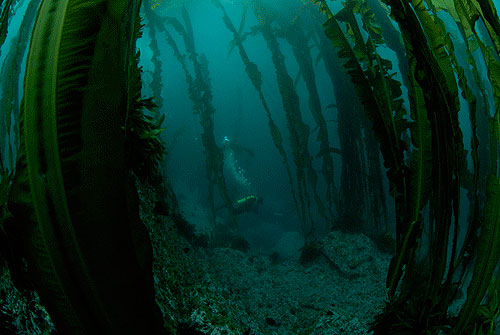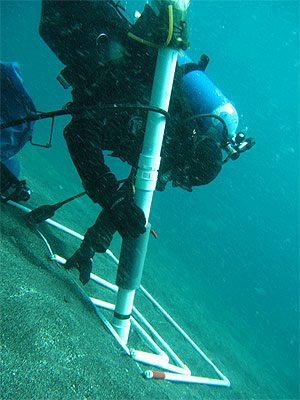 By NED ROZELL April 23, 2010
"Diving off Nome where they were doing offshore dredging (for gold) was close, but nothing compares to what we found around Kasatochi," said Jewett, who dives as part of his job with the University of Alaska Fairbanks' School of Fisheries and Ocean Sciences. Kasatochi is an 800-acre island in the Aleutians that destroyed itself with an eruption in August 2008. Its 40,000-foot ash cloud disrupted Alaska Airlines flights from Seattle to Anchorage. Almost nothing on the island survived its transformation from lush and green to gray and muddy.  Photo by Shawn Harper
During Kasatochi's violent eruption, the island "blooped out," as one biologist put it, becoming 31 percent bigger as sand and ash flowed out to sea. That sand was mostly what Jewett and fellow divers Héloïse Chenelot and Max Hoberg found off Kasatochi.
"There is absolutely nothing there it is barren," Jewett said of some of the spots in which they dove. "There were no fishes, no large invertebrates, and plants were rare. There were no crabs, sea stars, or urchins that you would see at any other site in the Aleutians." The erupted ash and mud created an apron of gray that now surrounds the island. "The lights probably went out underwater (during the eruption)," Jewett said. "Mobile organisms might have been able to get out of the way, but the sponges, kelp, and urchins were buried." The thick beds of kelp that used to make motoring ashore in a skiff difficult were gone around most of the island, but Jewett and the others eventually saw something other than sand on their dives. "We were delighted to see rocks, and then we found barnacles - our first sign of animal life," Jewett said. The barnacles were large enough that Jewett and Hoberg decided they had survived the eruption, which probably heated the sea just offshore considerably. They also found living diatoms - single-celled algae with cell walls made of glass. The diatoms were a species that is often one of the first colonizers of bare rock after a disturbance. Another discovery was amphipods, tiny creatures that look somewhat like shrimp. They are also among the first creatures to return to a barren, undersea landscape. Like the island itself, the shallow waters offshore of Kasatochi are still a desert, but recovery is underway. Jewett expects that a few healthy strands of kelp the divers found - the fastest growing kelp in the world that can grow a meter a day in the summer - will continue to prosper as the fine sediments erode away. "There is a remnant of algae for future recolonization," Jewett said. "There is seed to replenish this otherwise sterile environment."
University of Alaska Fairbanks, in cooperation with the UAF research community. Ned Rozell [nrozell@gi.alaska.edu] is a science writer at the institute. Publish A Letter in SitNews Read Letters/Opinions
|
||
